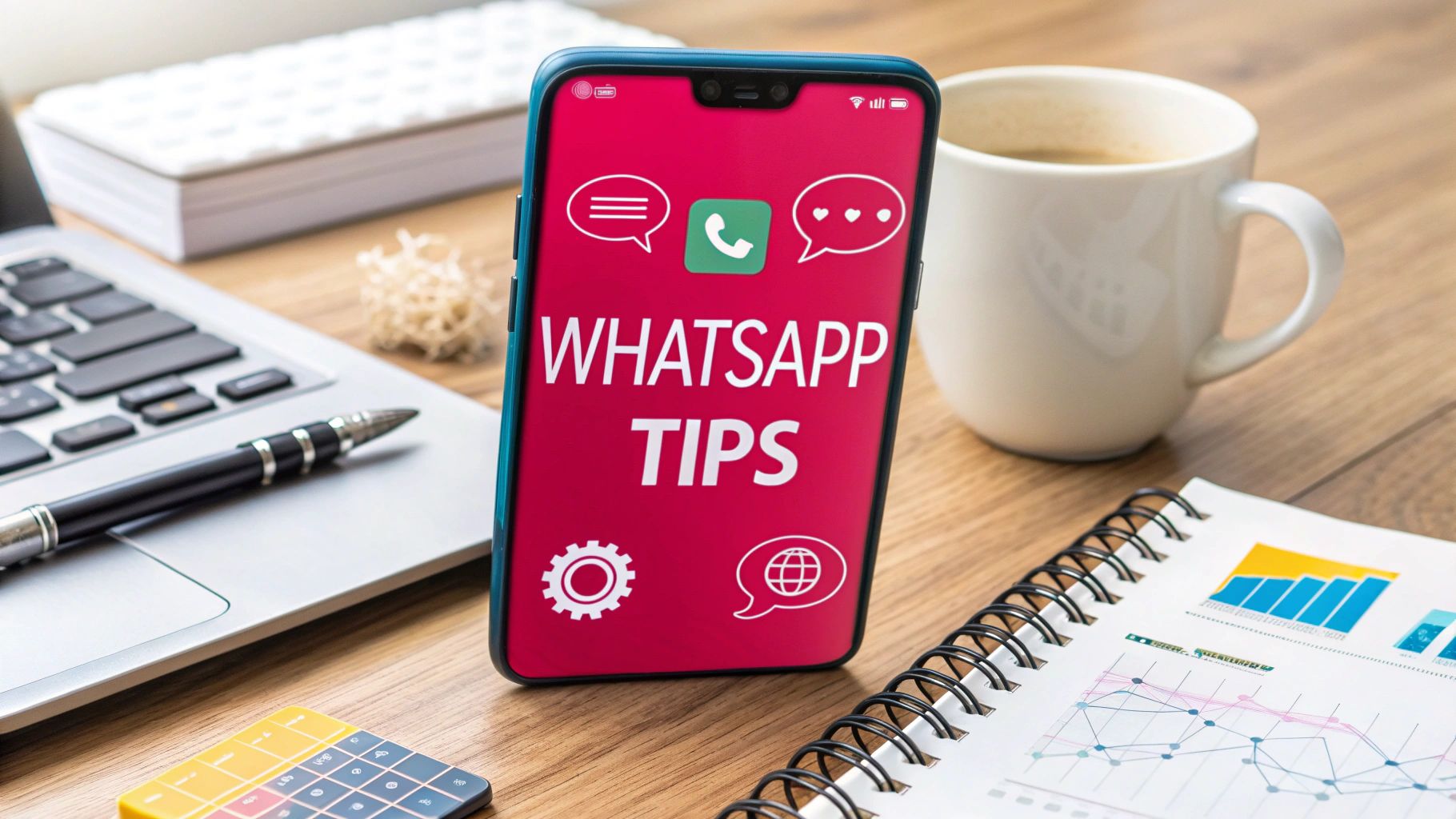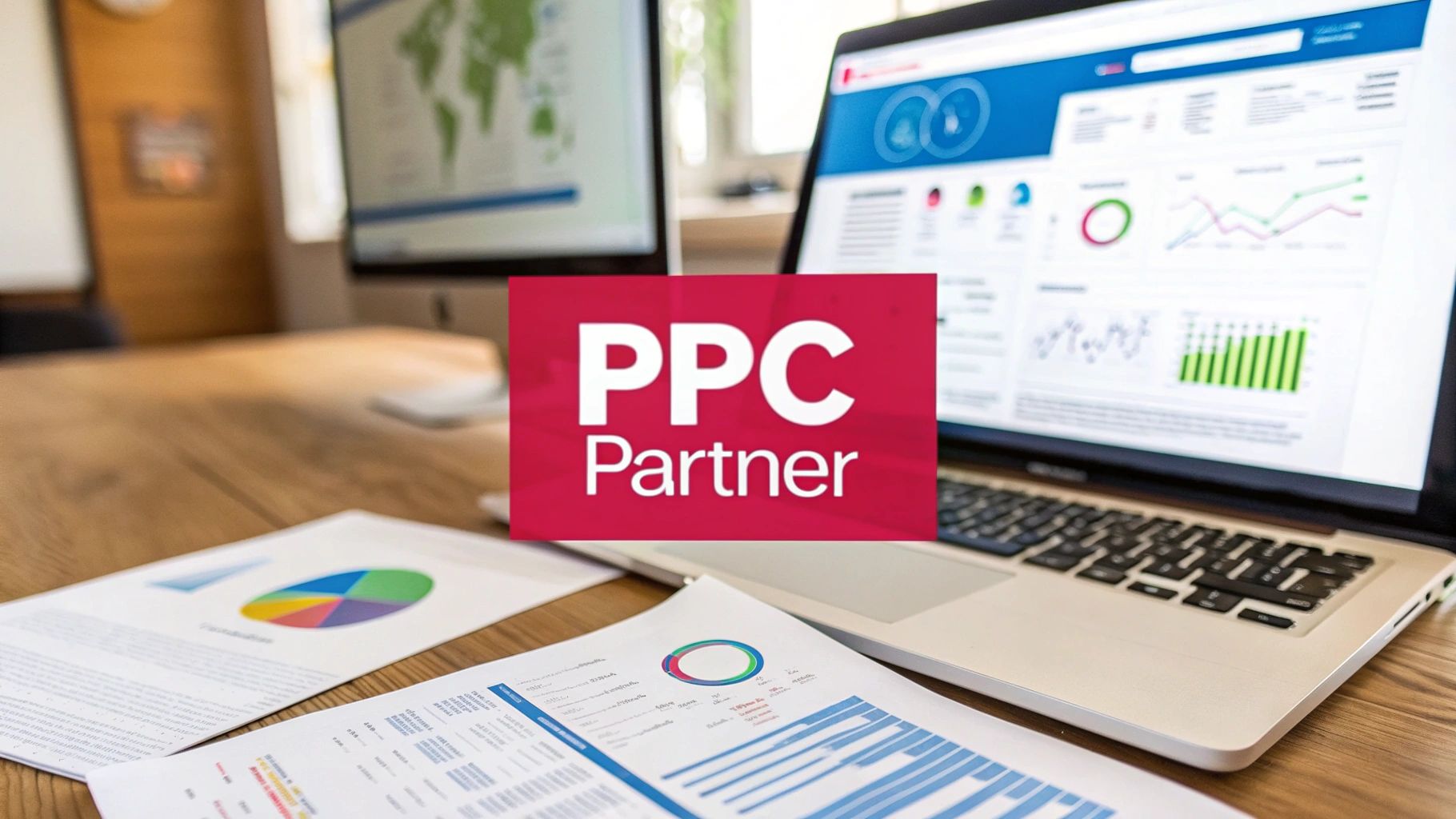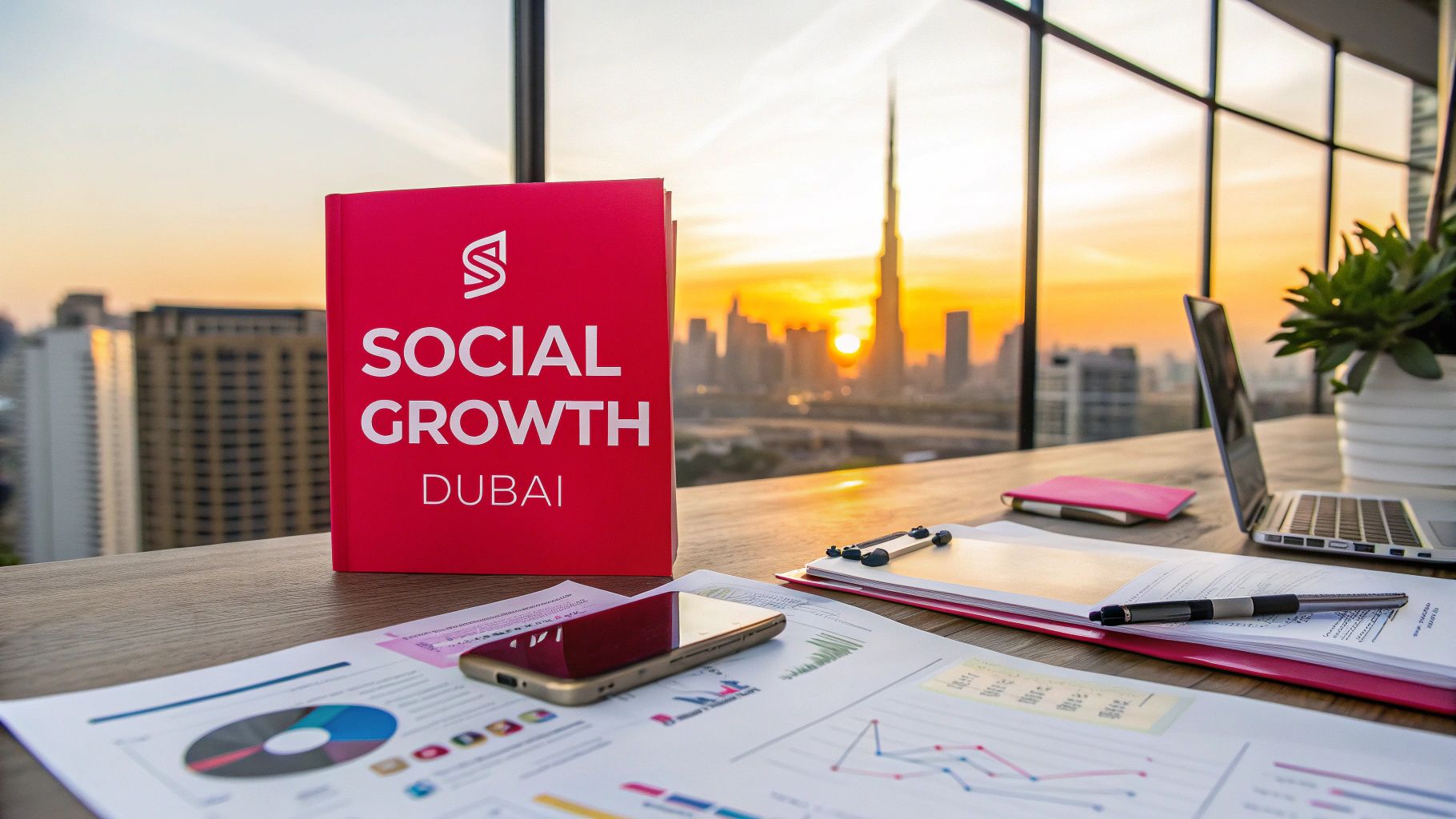Why Your Business Needs to Master WhatsApp Marketing Now
In the bustling digital marketplace, connecting with customers on a personal, immediate level is no longer a luxury, it's a necessity. With billions of active users globally and unparalleled penetration in regions like the UAE, WhatsApp has evolved from a simple messaging app into a formidable marketing powerhouse. Ignoring it means leaving valuable conversations, and revenue, on the table. However, success on this platform requires more than just sending messages; it demands a nuanced strategy that respects privacy, delivers value, and builds genuine relationships.
This article provides a comprehensive roundup of critical WhatsApp marketing tips, moving beyond generic advice to offer actionable, data-driven strategies. We will show you precisely how to turn this channel into a core part of your business growth.
You will learn how to:
- Build a compliant, opt-in subscriber list ethically.
- Leverage the WhatsApp Business API for sophisticated automation.
- Craft engaging multimedia content that captures attention.
- Personalise messages using customer data for maximum impact.
- Use features like Status, Groups, and Broadcast Lists strategically.
Whether you are a startup founder, an e-commerce retailer, or part of an established corporation, these insights will equip you to master WhatsApp marketing. By implementing these techniques, you can connect with your audience in a more direct and meaningful way, driving conversions and cultivating the lasting customer loyalty that defines modern business success.
1. Build an Opt-in Subscriber List
The cornerstone of any effective and ethical WhatsApp marketing strategy is a robust, permission-based subscriber list. Unlike traditional marketing channels where you might broadcast to a wide, untargeted audience, WhatsApp is an intimate, personal space. Success here hinges on communicating with users who have explicitly agreed to receive your messages. This opt-in approach is not just a best practice; it is a fundamental requirement of WhatsApp's Business Policy, ensuring your messages are welcomed rather than viewed as spam.
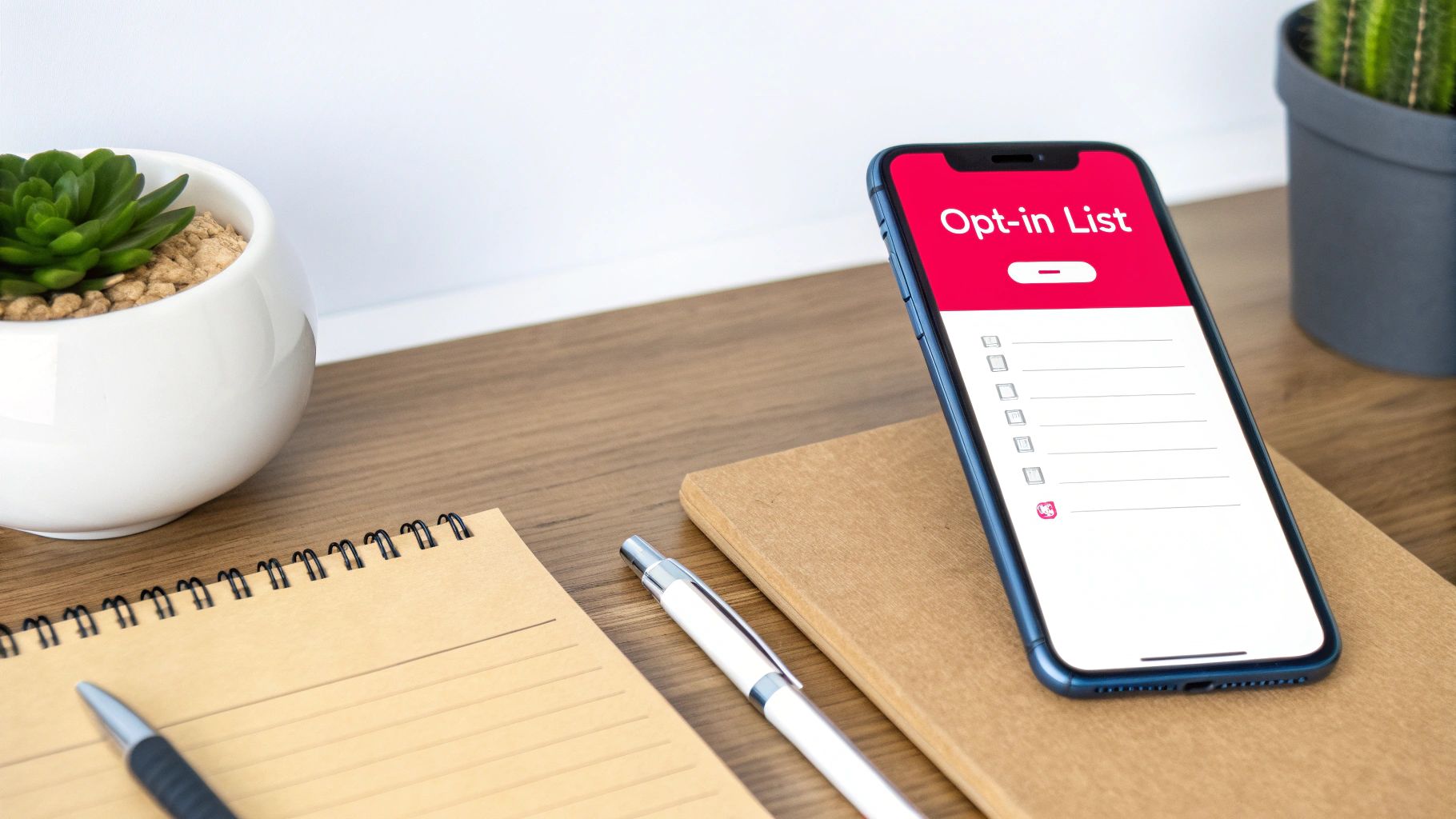
Building this list involves creating clear and convenient ways for customers to consent. By prioritising permission, you not only comply with privacy regulations but also guarantee higher engagement rates, as you are connecting with an audience that is already interested in your brand. This method lays the groundwork for all other WhatsApp marketing tips, making it the essential first step.
How to Implement a Successful Opt-in Strategy
Integrating opt-in mechanisms across all customer touchpoints is key to steadily growing your subscriber base. The goal is to make it incredibly easy for an interested customer to say "yes" to your communications.
- Website and Landing Pages: Place clear opt-in forms or checkboxes on your homepage, blog posts, and dedicated landing pages. Use compelling calls-to-action like "Get Exclusive Deals on WhatsApp."
- Checkout Process: E-commerce brands like Myntra successfully use the checkout page to ask customers if they want order updates and exclusive offers via WhatsApp. This is a high-conversion touchpoint as the customer is already engaged.
- Social Media: Use the "click-to-chat" feature in your social media ads and profile bios to direct users to a WhatsApp conversation where they can opt-in.
- In-store QR Codes: For brick-and-mortar businesses, a simple QR code at the till or on promotional materials can lead customers directly to a subscription link, seamlessly bridging the physical and digital experience.
- Lead Magnets: Offer something valuable in exchange for a subscription. This could be a discount code, a free e-book, or access to exclusive content, a technique central to effective lead generation. For a deeper understanding of how to attract and convert prospects, you can explore various strategies for lead generation in Dubai.
Ultimately, a carefully cultivated opt-in list is your most valuable asset in WhatsApp marketing. It ensures your messages reach a receptive audience, dramatically increasing the potential for conversions and building lasting customer loyalty.
2. Leverage WhatsApp Business API for Automation
For businesses looking to scale their communication, the WhatsApp Business API is a transformative tool. While the standard WhatsApp Business app is excellent for small operations, the API unlocks the power of automation, integration, and large-scale messaging. It allows businesses to connect WhatsApp to their existing tech stack, like a CRM or e-commerce platform, enabling automated workflows that save time, reduce human error, and deliver a seamless customer experience 24/7. This is one of the most powerful WhatsApp marketing tips for growing companies.

By using the API, companies like BookMyShow can instantly send automated booking confirmations and event reminders, while banks like HDFC provide real-time transaction alerts. These automated, yet highly relevant, messages enhance customer trust and satisfaction. The API moves your WhatsApp strategy from a manual, one-to-one channel to a sophisticated, automated system capable of managing thousands of conversations simultaneously.
How to Implement WhatsApp API Automation Effectively
Getting started with the API requires partnering with a WhatsApp Business Solution Provider (BSP) who facilitates the integration. Once set up, the focus shifts to creating intelligent, customer-centric automated flows that add real value.
- Start with Essential Notifications: Begin by automating high-value, transactional messages. E-commerce brands like Swiggy use this for order confirmations, shipping updates, and delivery notifications. These are messages customers expect and appreciate, making them a perfect starting point.
- Develop Conversational Chatbots: Design chatbot flows that handle frequently asked questions (FAQs), such as queries about store hours, return policies, or service availability. The key is to make the interaction feel natural and helpful, not robotic.
- Use Quick Replies and Buttons: Guide users through conversations with pre-defined quick reply buttons. Instead of asking a user to type out a full response, you can offer options like "Track My Order," "Speak to an Agent," or "View Products" to streamline the interaction.
- Integrate with Your CRM: Connect the WhatsApp API to your Customer Relationship Management (CRM) system. This creates a unified customer view, allowing your support team to access conversation history and customer data seamlessly, leading to more personalised and efficient service. To see how this fits into a broader strategy, you can explore these marketing automation workflow examples.
Ultimately, leveraging the WhatsApp Business API is about enhancing efficiency and customer experience at scale. By automating routine communications, you free up your team to handle more complex issues, ensuring your customers receive prompt and accurate information at every stage of their journey.
3. Create Engaging Multimedia Content
Moving beyond simple text messages is crucial for capturing attention in a crowded chat list. WhatsApp is a powerful visual medium, supporting a wide range of formats including images, videos, audio notes, and interactive documents. Leveraging multimedia is one of the most effective WhatsApp marketing tips for making your brand communications more dynamic, memorable, and shareable. Engaging content breaks the monotony of text, conveys information faster, and evokes a stronger emotional response from your audience.
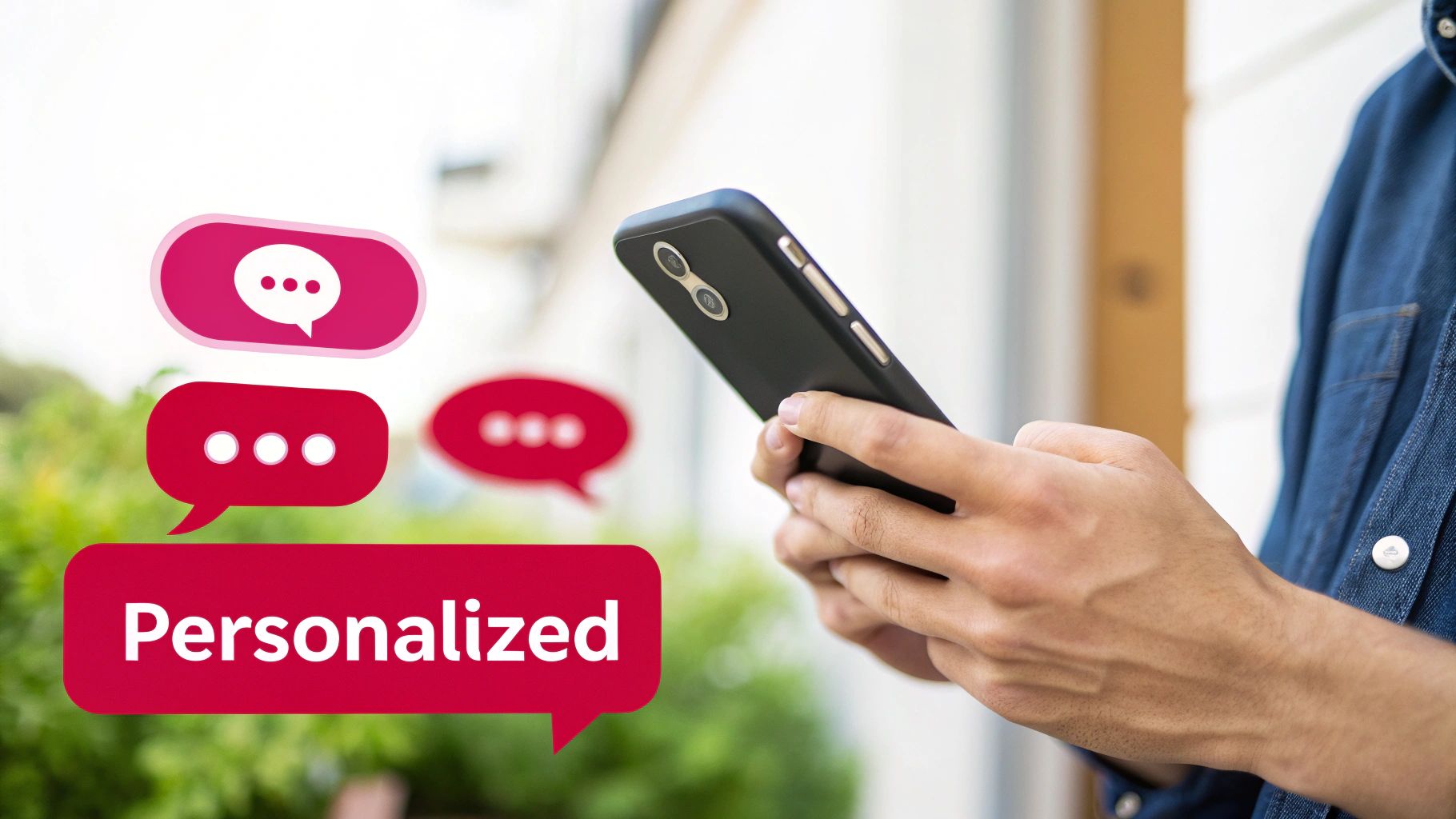
Brands that successfully integrate rich media into their strategy see significantly higher engagement rates. For instance, an e-commerce brand like Nykaa can share short makeup tutorial videos, or a jewellery brand like Tanishq can send a high-resolution catalogue of its latest collection. This visual and interactive approach helps customers better understand products and services, driving interest and simplifying the path to purchase.
How to Implement a Successful Multimedia Strategy
The key to a successful multimedia strategy is to align the content format with your campaign goal and brand identity. It is not just about sending an image; it is about sending the right kind of media to the right audience segment at the right time.
- High-Quality Visuals: Use crisp, high-resolution images and graphics that are professionally designed and reflect your brand's aesthetic. Domino's, for example, could send an interactive menu card with mouth-watering pictures of its pizzas.
- Short, Compelling Videos: Keep video content concise, ideally under 30 seconds, to maintain viewer attention. Use them for product demonstrations, behind-the-scenes glimpses, or customer testimonials.
- Personalised Audio Messages: For a highly personal touch, use voice notes to thank a customer for a purchase or to announce a special, limited-time offer. This humanises your brand and builds a stronger connection.
- Interactive Catalogues and Documents: Utilise WhatsApp's document-sharing feature to send PDFs like product catalogues, lookbooks, or detailed guides. This allows users to browse your offerings without leaving the app.
- Optimise File Sizes: Ensure all media files are compressed for mobile viewing. Large files take longer to load and consume more data, which can frustrate users and lead to lower engagement.
Ultimately, a thoughtful multimedia approach transforms your WhatsApp channel from a simple notification service into a rich, interactive brand experience. For businesses looking to elevate their visual communication, exploring professional content creation services can provide the expertise needed to produce compelling and effective assets.
4. Implement Strategic Message Timing
Timing is a critical, yet often overlooked, element in the success of your WhatsApp marketing efforts. Unlike email, where messages might sit in an inbox for hours, WhatsApp notifications are immediate and personal, appearing directly on a user’s lock screen. Sending a message at the right moment can significantly boost open rates, engagement, and conversions, while poor timing can lead to annoyance, opt-outs, and message fatigue. Strategic timing ensures your communication feels helpful and relevant, rather than intrusive.
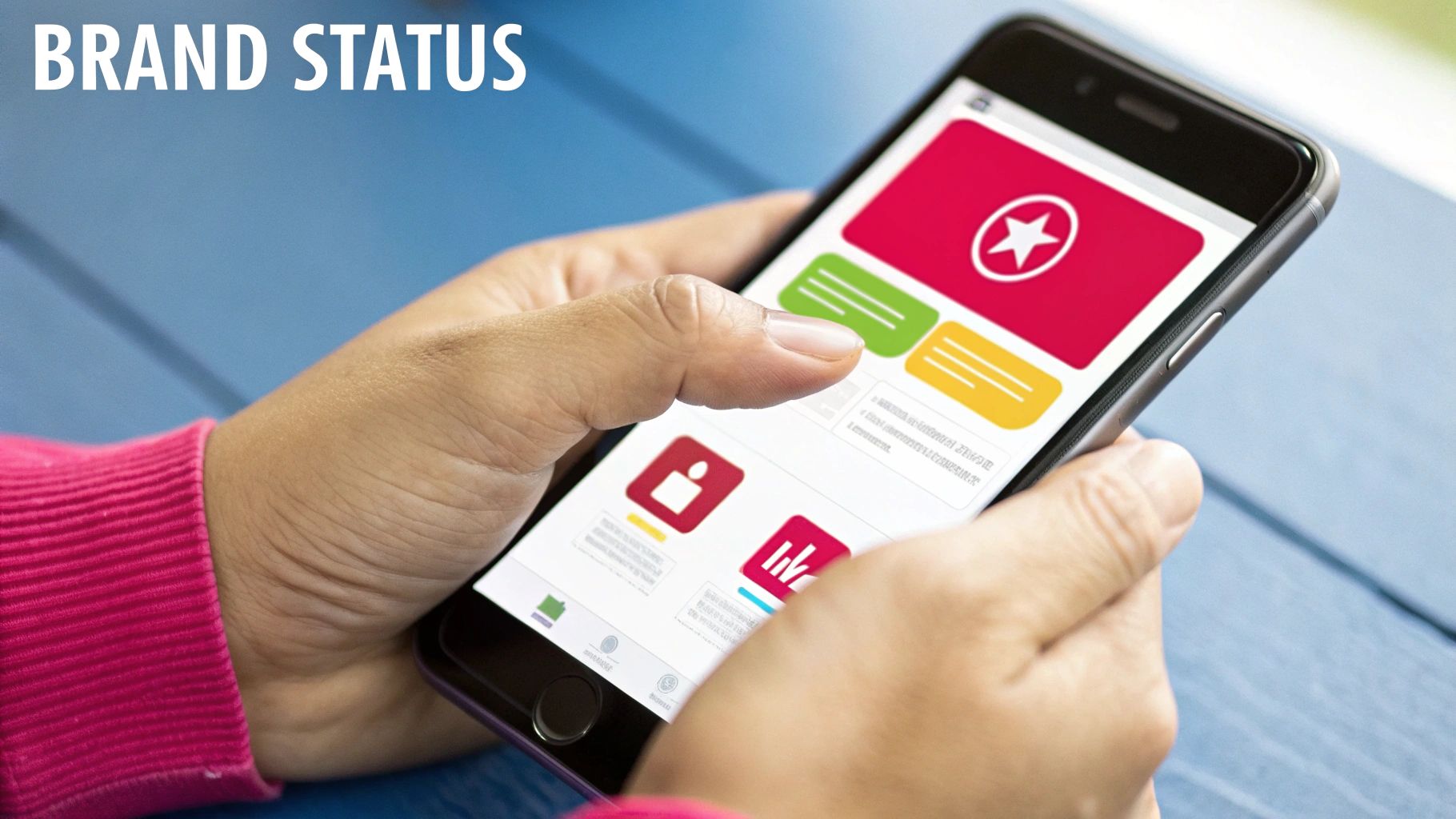
The goal is to align your messages with your audience's daily routines and moments of highest receptivity. A well-timed message demonstrates that you understand and respect your customer’s personal time. For instance, a food delivery service sending lunch deals at midday is far more effective than sending them at 9 AM. Mastering this aspect of WhatsApp marketing tips transforms your campaigns from a simple broadcast into a timely, welcome interaction that drives action.
How to Implement Strategic Message Timing
Developing a successful timing strategy requires a blend of audience analysis, testing, and common sense. The key is to think from the customer's perspective and schedule your communications to coincide with when they are most likely to be engaged with their phone.
- Analyse Audience Behaviour: Use analytics from your WhatsApp Business API provider or other platforms to identify when your audience is most active. Look for patterns in engagement times and tailor your schedule accordingly.
- A/B Test Different Time Slots: Don't just assume. Run controlled tests by sending the same campaign to different segments at various times of the day and week. Measure open rates and click-through rates to find your "golden hours."
- Align with User Context: Think about the context of your message. Food delivery apps like Zomato or Talabat find immense success sending lunch offers between 11 AM and 1 PM. Similarly, fashion brands like Myntra often time their weekend sale announcements for Friday evenings when users are planning their shopping.
- Respect Personal Boundaries: Avoid sending promotional messages during common "do not disturb" hours, such as early mornings (before 9 AM) or late nights (after 9 PM), unless they are critical transactional alerts like fraud warnings.
- Consider Regional and Cultural Nuances: If you operate in multiple time zones or serve diverse cultural groups, adjust your timing. For example, business hours and weekend schedules can vary significantly, especially in regions like the UAE where the workweek may differ.
- Leverage Scheduling Tools: Use the scheduling features available in WhatsApp marketing platforms. This allows you to plan your campaigns in advance and ensure they are delivered at the optimal moment, maintaining consistency without manual effort.
5. Personalize Messages with Customer Data
In an era where consumers are inundated with generic marketing messages, personalization is the key to cutting through the noise. WhatsApp, being a direct and personal communication channel, is uniquely suited for this approach. Personalization involves using customer data, such as purchase history, browsing behaviour, and demographic information, to craft messages that are highly relevant and tailored to the individual. This transforms a broadcast message into a one-on-one conversation, significantly boosting engagement and conversion rates.
When a customer receives a message that acknowledges their preferences or past interactions, it makes them feel valued and understood. E-commerce giants like Amazon India excel at this, sending personalised product recommendations based on a user's browsing history. This level of customisation moves beyond basic marketing into the realm of helpful, customer-centric service, which is a cornerstone of effective WhatsApp marketing tips.
How to Implement a Successful Personalization Strategy
Successfully implementing personalization requires a systematic approach to collecting, segmenting, and utilising customer data. The goal is to make every message feel like it was written specifically for the recipient.
- Start with the Basics: The simplest yet most effective form of personalization is using the customer's name. A message that starts with "Hello [First Name]" is immediately more engaging than a generic greeting.
- Segment Your Audience: Group your subscribers based on meaningful criteria like purchase history, location, or expressed interests. For instance, a clothing brand can send offers for women's wear only to female subscribers who have previously purchased from that category.
- Utilise Dynamic Content: Leverage dynamic variables to insert specific, relevant details into your messages. Flipkart often uses this to suggest complementary products based on a recent purchase, such as recommending a phone case to someone who just bought a new smartphone.
- Create Lifecycle-Based Offers: Tailor your promotions to where the customer is in their journey. A new subscriber might receive a welcome discount, while a loyal, long-term customer could get an exclusive "thank you" offer.
- Embrace Advanced Techniques: To truly stand out, consider advanced methods like dynamic media. Exploring personalized video marketing strategies can show you how to adapt video content to individual profiles, creating a powerful and unique engagement experience.
- Respect Privacy: Always be transparent about the data you are collecting and how you are using it. Ensure your practices comply with privacy regulations and offer customers easy ways to manage their data preferences.
By personalising your communications, you build stronger, more meaningful relationships with your customers. This not only drives immediate sales but also fosters long-term loyalty and brand advocacy.
6. Provide Excellent Customer Service
Beyond marketing broadcasts, WhatsApp has rapidly evolved into a primary channel for customer service, prized for its immediacy and personal feel. Leveraging the platform to deliver quick, effective, and friendly support is a powerful way to enhance customer satisfaction, foster trust, and build unshakable brand loyalty. Unlike slower channels like email, WhatsApp allows for real-time, conversational problem-solving that customers appreciate.
This direct line of communication transforms customer service from a reactive cost centre into a proactive loyalty-building engine. When customers know they can easily reach you for help, they feel more confident in their purchasing decisions. Brands like ICICI Bank, which offers a full suite of banking services and query resolution on WhatsApp, and e-commerce player Urban Ladder, which handles product inquiries and order support, showcase how effective this channel can be for complex interactions, making it one of the most crucial WhatsApp marketing tips for retention.
How to Implement Excellent Customer Service on WhatsApp
Building a successful customer service operation on WhatsApp requires a blend of speed, efficiency, and a human touch. The goal is to resolve issues quickly while making the customer feel valued and heard.
- Set Clear Response Time Expectations: Inform customers of your support hours and expected response times using an automated welcome message. Managing expectations from the outset prevents frustration.
- Use Quick Replies for Common Questions: The WhatsApp Business API allows you to create templated "quick replies" for frequently asked questions about shipping, returns, or product details. This frees up your agents to focus on more complex issues.
- Train Support Staff in WhatsApp Etiquette: Communication on WhatsApp is more informal than email. Train your team to be professional yet friendly, using emojis where appropriate to convey tone and empathy, but always maintaining brand voice.
- Create a Knowledge Base for Faster Resolution: Equip your support team with a comprehensive internal knowledge base. This allows them to find accurate information quickly and provide consistent answers to customer inquiries.
- Implement Escalation Procedures: Define a clear process for escalating complex or sensitive issues to a senior team member or another department. This ensures no customer query gets lost and that difficult problems are handled by the right people. For an in-depth understanding of how to optimise your customer support and manage inquiries efficiently, refer to this complete WhatsApp Business customer service guide.
By prioritising exceptional service on this channel, you not only solve immediate problems but also create brand advocates who are more likely to make repeat purchases and recommend you to others.
7. Use WhatsApp Status for Brand Awareness
Beyond direct messaging, WhatsApp Status offers a dynamic and engaging way to connect with your audience. Similar to Instagram or Facebook Stories, this feature allows businesses to share ephemeral content-images, videos, and text that disappears after 24 hours. It provides an excellent, non-intrusive channel for building brand personality, sharing timely updates, and creating a sense of urgency around special offers without cluttering a user's primary chat inbox.
WhatsApp Status is particularly effective for humanising your brand. By sharing behind-the-scenes glimpses, quick tips, or daily specials, you can foster a more personal connection with customers. This feature is ideal for maintaining top-of-mind awareness, ensuring your brand remains visible to an audience that has already saved your contact number, signaling a high level of interest. For businesses looking for creative and cost-effective whatsapp marketing tips, leveraging the Status feature is a powerful strategy.
How to Implement a Successful WhatsApp Status Strategy
A consistent and creative approach is vital for making your WhatsApp Status updates a must-see for your contacts. The goal is to deliver value and entertainment, encouraging users to check your status regularly.
- Showcase Daily Operations: A local restaurant can share videos of chefs preparing the daily special, or a fashion boutique can post photos of new arrivals as they are unboxed. This authentic content builds excitement and trust.
- Run Flash Sales and Limited-Time Offers: Use the 24-hour lifespan of a Status update to create urgency. Post a unique discount code or announce a flash sale that is only available to those who view your status, rewarding your most engaged followers.
- Share Value-Added Content: Post quick tutorials, industry tips, or user-generated content. For example, a service business could share short video testimonials from happy clients or a quick "how-to" guide related to their expertise.
- Promote New Content or Events: Announce a new blog post, an upcoming webinar, or an in-store event. Include a simple call-to-action like "DM for the link!" to drive direct engagement from the status itself.
- Gather Quick Feedback: Use the text status to ask simple questions or run informal polls to gather customer opinions on a new product or service idea, making your audience feel involved in your brand's journey.
By thoughtfully curating your WhatsApp Status, you can transform it from a simple feature into a strategic tool for brand awareness, community building, and driving direct customer action.
8. Create WhatsApp Groups and Broadcast Lists
Leveraging WhatsApp Groups and Broadcast Lists offers two distinct yet powerful avenues for communication. While both are designed for sending messages to multiple people, their functions are fundamentally different, and choosing the right one depends entirely on your marketing objective. Groups foster community and two-way dialogue, whereas Broadcast Lists are for one-way announcements that maintain individual privacy.
Mastering both is one of the most effective WhatsApp marketing tips for segmenting your communication strategy. Groups are ideal for building an engaged community, such as a VIP club for loyal customers or a support circle for a specific product. Broadcast Lists, on the other hand, are perfect for sending promotional offers, newsletters, or important updates directly to a large audience without creating a noisy, public chat. This dual approach allows businesses to engage on a personal level while also scaling their outreach efforts efficiently.
How to Implement Groups and Broadcasts Effectively
The key to success lies in understanding when to foster community and when to simply inform. Using these features strategically prevents message fatigue and ensures your communications are always relevant and welcome.
- Define a Clear Purpose: Before creating either a group or a broadcast list, define its specific purpose. Is it for exclusive content, customer support, or event announcements? A fitness trainer might use a Group for a 30-day challenge community, while a real estate agent would use a Broadcast List for new property alerts.
- Set Group Guidelines: For WhatsApp Groups, establish and pin clear rules of engagement from the start. This includes guidelines on appropriate topics, promotional content from members, and general etiquette. Active moderation is crucial to keep the conversation valuable and on-topic.
- Segment Your Broadcast Lists: Avoid sending generic messages to everyone. Create different Broadcast Lists based on customer interests, purchase history, or location. A boutique could have separate lists for customers interested in menswear, womenswear, or accessories.
- Provide Exclusive Value: Whether in a group or a broadcast, make your members feel special. Share exclusive discount codes, early access to sales, or behind-the-scenes content that isn't available on other channels. This rewards their participation and strengthens loyalty.
- Encourage Interaction in Groups: Use polls, questions, and prompts to stimulate conversation within your groups. An educational institute could create study groups where a moderator posts weekly discussion questions, encouraging peer-to-peer learning and engagement.
WhatsApp Marketing Tips: 8-Point Strategy Comparison
| Strategy | Implementation Complexity 🔄 | Resource Requirements ⚡ | Expected Outcomes 📊 | Ideal Use Cases 💡 | Key Advantages ⭐ |
|---|---|---|---|---|---|
| Build an Opt-in Subscriber List | Medium – requires consent processes | Moderate – ongoing effort to maintain | High engagement, better deliverability | Permission-based marketing, compliant campaigns | Higher engagement, privacy compliance |
| Leverage WhatsApp Business API for Automation | High – technical setup and maintenance | High – costs and technical resources | Efficient large-scale messaging, 24/7 service | Automating customer communication, notifications | High volume handling, detailed analytics |
| Create Engaging Multimedia Content | Medium – content creation demands | Moderate to high – media production | Better engagement, brand recall | Brands needing rich interactive content | Stronger customer connection, versatile formats |
| Implement Strategic Message Timing | Medium – requires audience analysis | Low to moderate – scheduling tools | Increased open rates and reduced fatigue | Optimizing delivery times for maximum impact | Improved message visibility, reduced irritation |
| Personalize Messages with Customer Data | High – complex data and campaign setup | High – data management and content customization | Higher conversions and loyalty | Targeted marketing using customer behavior and data | Increased relevance, customer satisfaction |
| Provide Excellent Customer Service | Medium to high – dedicated support staff | Moderate – staffing and system integration | Better satisfaction and loyalty | Real-time customer support and issue resolution | Instant communication, personal support |
| Use WhatsApp Status for Brand Awareness | Low – simple content creation | Low – minimal resources | Increased brand visibility, urgency creation | Quick updates, storytelling, time-sensitive promos | Cost-effective, informal engagement |
| Create WhatsApp Groups and Broadcast Lists | Medium – requires active management | Low to moderate – moderation and content | Community building and direct feedback | Building communities, mass communication with privacy | High engagement, peer interaction |
Start Your Winning WhatsApp Conversation Today
We have journeyed through a comprehensive roadmap of powerful WhatsApp marketing tips, moving far beyond simple messaging into the realm of strategic, conversion-focused communication. The core theme connecting every strategy, from building an ethical opt-in list to leveraging the WhatsApp Business API, is the profound shift from broadcasting to genuine conversation. This is the future of customer engagement, and it’s happening right now on the world's most popular messaging platform.
Merely adopting WhatsApp is not enough. The true competitive advantage lies in the thoughtful execution of these strategies. It’s about understanding that each message is an opportunity to build trust, provide value, and strengthen your brand's relationship with its audience. The insights we have shared are designed to be your blueprint for achieving precisely that.
Recapping Your Path to WhatsApp Mastery
Let's quickly synthesise the essential pillars we've discussed. Mastering these interconnected elements is what separates a basic WhatsApp presence from a high-performing marketing channel:
- Permission is Paramount: The foundation of all successful WhatsApp marketing is a high-quality, opt-in subscriber list. Never compromise on consent; it builds trust and ensures compliance.
- Automation with a Human Touch: The WhatsApp Business API is your gateway to scaling operations. Use it for automated responses, order updates, and segment-based campaigns, but always ensure the experience feels personal, not robotic.
- Content is Conversation: Move beyond text. Use a rich mix of images, videos, GIFs, and voice notes to create dynamic, engaging content that captures attention and encourages interaction.
- Personalisation Drives Connection: Leverage customer data to tailor your messages. Address subscribers by name, reference past purchases, and send offers relevant to their specific interests. This level of personalisation is no longer a luxury; it’s an expectation.
- Service as a Marketing Tool: Excellent, real-time customer support via WhatsApp can be your most effective marketing asset. Solving problems quickly and efficiently fosters immense loyalty and positive word-of-mouth.
From Theory to Tangible Business Growth
Implementing these WhatsApp marketing tips isn't just an academic exercise. It translates directly into measurable business outcomes. By respecting your audience's privacy with opt-in lists, you cultivate a more engaged and receptive user base. Through strategic automation and personalisation, you can significantly improve efficiency while simultaneously making customers feel uniquely valued.
The result is a powerful flywheel effect. Engaging content and stellar service lead to higher customer satisfaction and loyalty. This, in turn, drives repeat business and encourages organic referrals. By using features like WhatsApp Status for brand storytelling and Groups for community building, you create an ecosystem where your brand is not just a seller but a valued part of your customer's daily digital life. This is how you transform a simple messaging app into a robust engine for lead generation, sales, and unparalleled brand affinity, a critical advantage in the competitive UAE market.
The journey to mastering WhatsApp marketing is ongoing. It requires a commitment to testing, learning, and adapting. Start small. Pick one or two strategies from this guide, implement them meticulously, track your results, and then build upon your successes. The key is to begin today, to start that first conversation, and to lay the groundwork for a more connected, responsive, and profitable future for your business.
Navigating the nuances of a platform like WhatsApp while aligning it with your broader business goals can be challenging. If you want to accelerate your success and implement a data-driven strategy from day one, expert guidance can make all the difference. Grassroots Creative Agency specialises in crafting bespoke WhatsApp marketing campaigns that deliver tangible results for businesses in Dubai and across the region.

